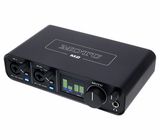I was looking for really compact, transportable, bus-powered interface with very low-noise mic preamps and a decent headphone amp and the MOTU M2 fulfils that. I was not interested in on-board processing such as Air mode (Focusrite) or 4k (SSL) as all of that can be done in the DAW. After some use it is still almost all positives but I will list the couple of things that hold it back from being perfect... for me.
POSITIVES:
- smaller dimensions that the direct competitors
- very clean mic preamps (-129dBu EIN)
- decent amount of gain (60dB), although less than the Focusrite 2i2 4th gen which has 69dB.
- gorgeous screen with detailed coloured level meters for both inputs and outputs
- bus powered
- powerful and transparent and noiseless-sounding headphone amp, even with relatively high-impedance headphones
- built-in 5-pin MIDI in and out
- good build quality. Some reviews have highlighted some lateral movement in the dials - mine doesn't do this so maybe MOTU has addressed this
- switchable 48V phantom power on *each* channel
- nice rubber feet - won't slide around the desk
- loop back (see caveat below)
NEGATIVES:
- there doesn't seem to be any way to gang the gain levels for channels 1 and 2. This would be important for stereo recording in XY, ORTF etc. This is one area where I think the Focusrite 2i2 has an advantage
MINOR
- loop back only appears as additional inputs within a DAW. What this means is that once the MOTU driver is installed, device software inputs 1 and 2 are whatever is plugged into physical inputs 1 and 2 on the M2 only, device software inputs 3 and 4 is the looped back stereo sound received from the computer into the M2, and device software inputs 5 and 6 are a mix of both the physical inputs and the looped back computer audio. This is quite a flexible arrangement when working in a DAW but when using something with less flexibility such as Audacity or OBS this can be an added complication. I am coming from Zoom's implementation of loopback where it is a switch made on the hardware which them simply mixes the loopbacked audio in with the hardware inputs (like inputs 5 & 6 on the M2). This has always been sufficient flexibility for me.
- bundled USB cable a bit short
- no dB indications on meters
- hard to see the benefit of the 32-bit float implementation on the M2. It is not like the implementations on field recorders like the Zoom F series or the Sound Devices Mix Pre series where it removes the possibility of clipping the sound file. You still need to watch you gain setting; exceeding 0dBFS results in clipped audio. I think the converters are just 24 bit and then this is converted to 32-bit format.
In summary, a great little budget interface which I can recommend.

